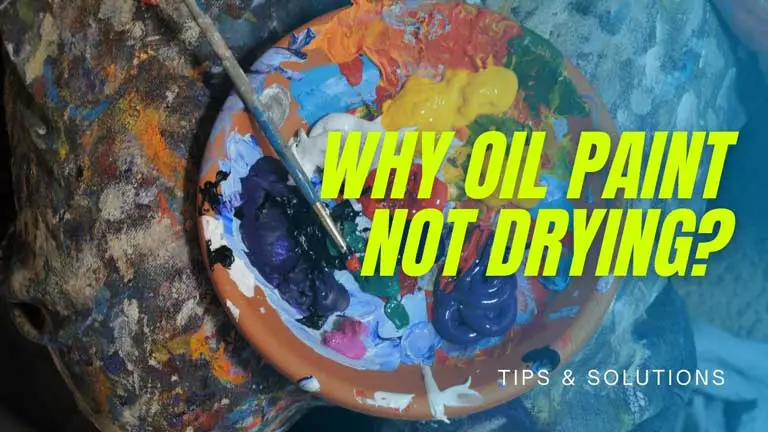Do you get bored waiting hours and hours for your oil paint to dry up? Oil paints surely test an artist’s patience, especially those who have always used fast-drying paints.
It can be a bit frustrating especially for the beginners to wait for days. However, there are some quick tips that you can apply to have a completely cured painting in a day or two.
Before you start oil painting, you must understand the science behind these miraculous paints. Professional artists mainly use oil paints as these are very technical and sometimes complicated. But their result is the most unique and long-lasting than other paints.
Let’s first start by understanding the nature of these paints. Scroll down to know five quick tips to fasten the drying time of your oil paints as well.

Why Oil Paint Takes Time to Dry?
The drying phenomenon of oil paints is an exciting aspect to understand. They have a minimal quantity of water due to which no evaporation occurs.
On the other hand, regular paints like acrylic, water and gouache paint dry up in no time. The Oil-mediums are quite different from other colors as they dry through a chemical reaction known as Oxidation. In this process, the oil paints gradually react with oxygen and polymerize.
The time required for the oil paints to get wholly cured and hard is called the drying time. The science behind the oil paints is that its drying time depends on several factors such as;
- Environment
- Brand of the paint you use
- Quality of the pigment
Quick Tips to Make Oil Paints Dry Faster
Here are some easy to implement but effective tips by which you can make oil paints dry faster-
1. Choose the Environment Carefully
Painting in a ventilated area can help a lot. Ensure that you open the windows, fans or any source of air for speeding up the drying time. Exposure to natural light also helps to increase the evaporation process of volatile solvents.
Bonus tip: You can also use hair dryers but make sure to adjust it on cool setting as a lot of heat can damage the painting’s shine. Also, blow the hairdryers at the back of canvas to ensure a debris-free painting.
2. Fat Over Lean Concept
Don’t feel puzzled by the flashy phrase. It is a theory that explains the artists to combine the drying mediums or thinners with their oils. Here is a trick for you:
When applying the initial layers, use more drying medium and less oil paint. This will help the initial layers to dry faster. And then, you can apply the finishing layers that can have more oil paint and less drying medium. However, you must know which drying medium works best for you.
Bonus tip: You can use turpentine to thin your oil paint before applying the base layer
3. Use Faster-Drying Pigments
Before you start with oil paints; you must have a quick sneak peak of different types of pigments that you can play with to speed up the drying process. Following are the colours that we have sorted out and these will surely help you in your painting career:
Fast drying oil paints
- Cobalt colours
- Burnt Sienna and Raw Sienna
- Naples Yellow
- All the Manganese colours
- Chrome Yellow and Red
- Lead white
Slow drying oil paints
- Zinc White
- Vermilion
- Black colors like lamp, charcoal etc.
- Alizarin crimson
- Cadmium colors
Bonus tip: If using slow drying colors is a requirement, then to increase their drying process you can mix them with fast drying oils.
4. Use Acrylic Paint Initially
Imagine if you have an exhibition in a week or you need to present your artwork to your customer. Then what to do? To speed up the entire painting process, you can start your basic strokes with acrylic paints as it dries much faster than oil paints. Use oil paints for final layers.
Furthermore, many artists prefer layer painting for finely detailed artworks. Using oil paints on all the layers can affect the drying time of the canvas. The drying time ranges from 24 hours to days or even months. However, applying acrylic paints in the initial layers would be a lot of help.
Bonus tip: Do not use acrylic paints on oil paints as this would cause the colors to mix up.
5. Apply Thin Layers when you Start
An essential fact to remember is that thick layers of oil require an ample amount of time to dry out. As we have mentioned above that a chemical reaction occurs that causes oil paints to remain wet for hours, days or even months. Therefore, use thin layers when you are starting to paint.
Here, Fat over Lean concept comes in action. Apply thin layers of oil, let it dry out and then apply the thick layers.
Bonus tip: You can select those oil paints that already have Linseed oil which would ensure that your oil medium has a thin consistency and quickly dries out.
Conclusion
All in all, oil paints are always fun to play with as they can open the doors to the world of colors that you can explore and enjoy. However, before you step into this colorful world, you must know the tips and tricks that would enhance the quality of your work. And don’t forget to PRACTICE. PRACTICE. and PRACTICE.
Leave a Reply